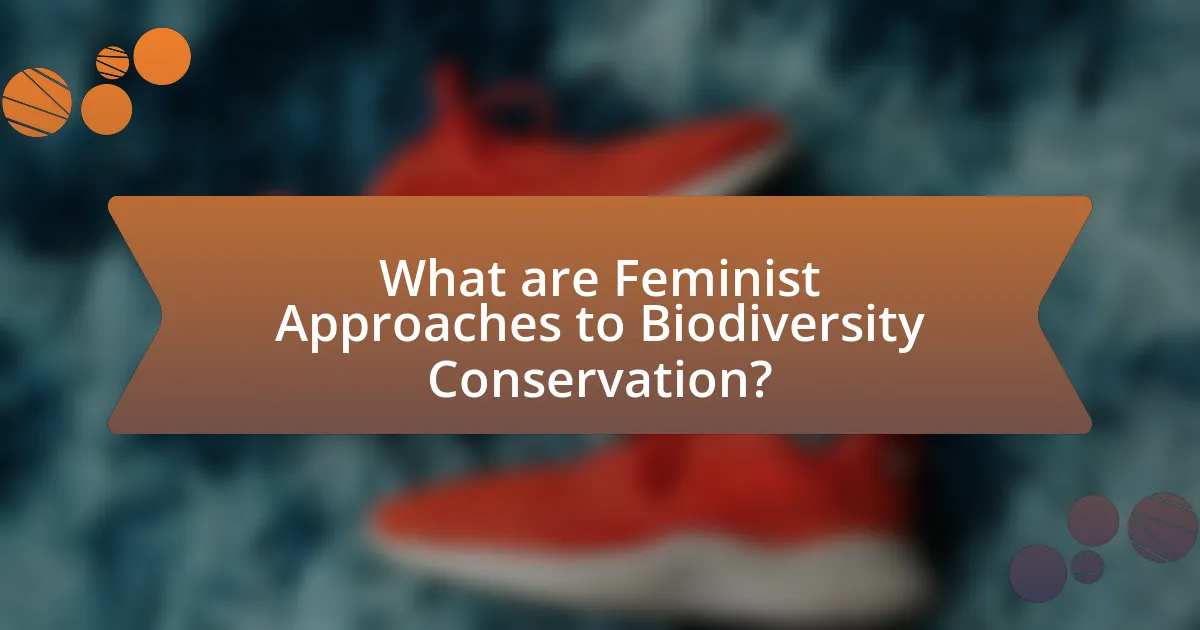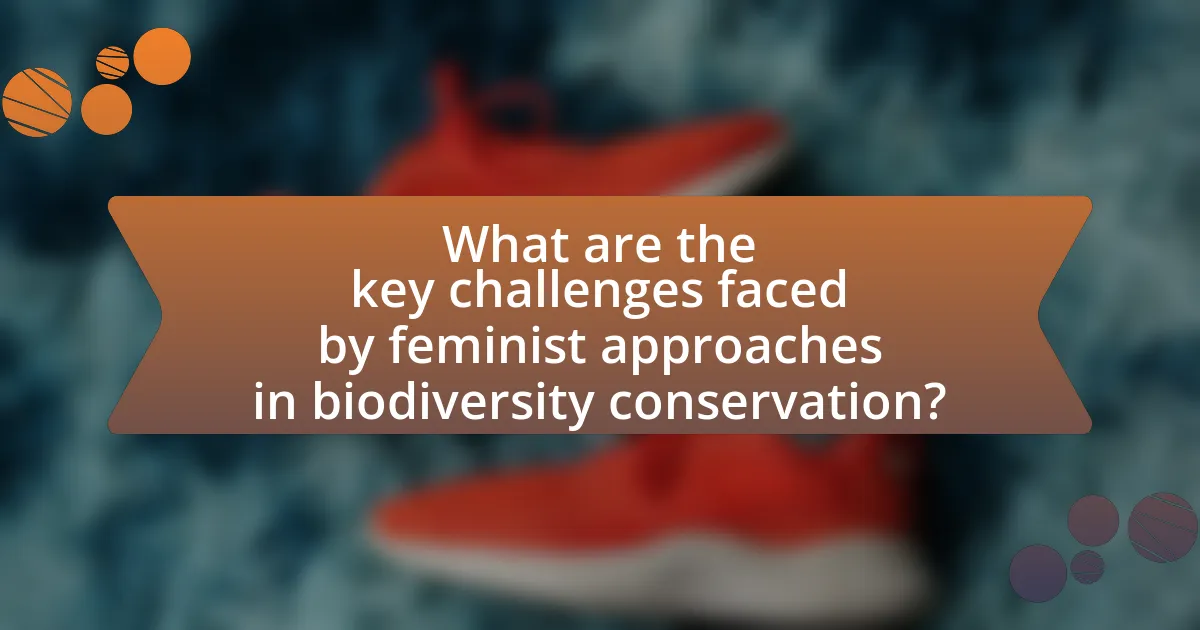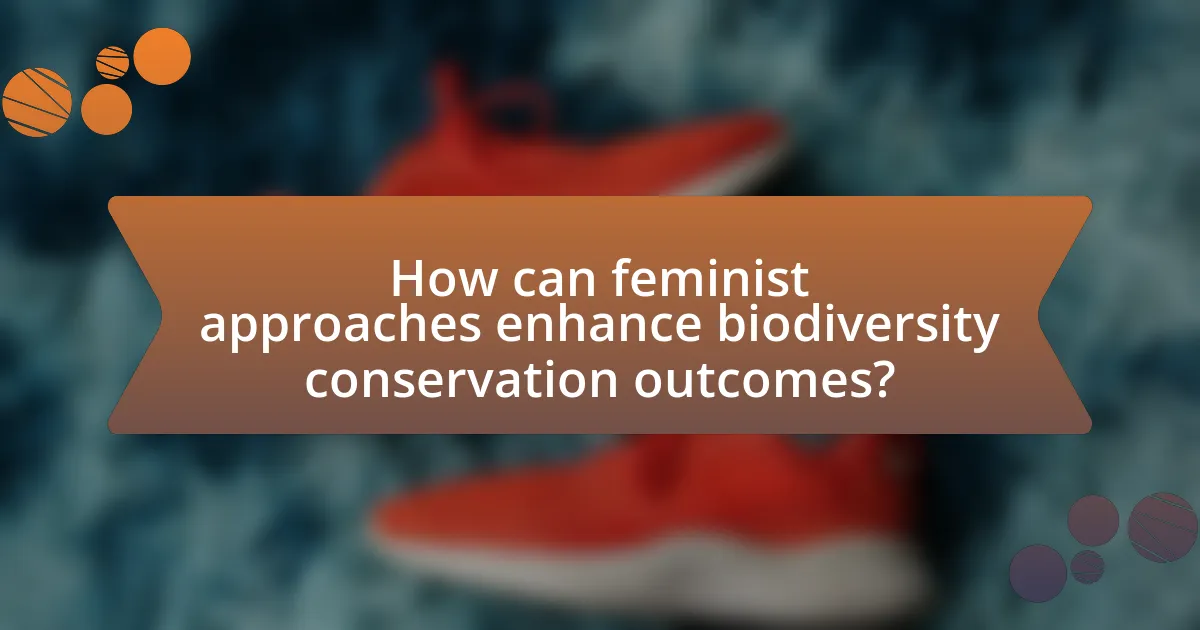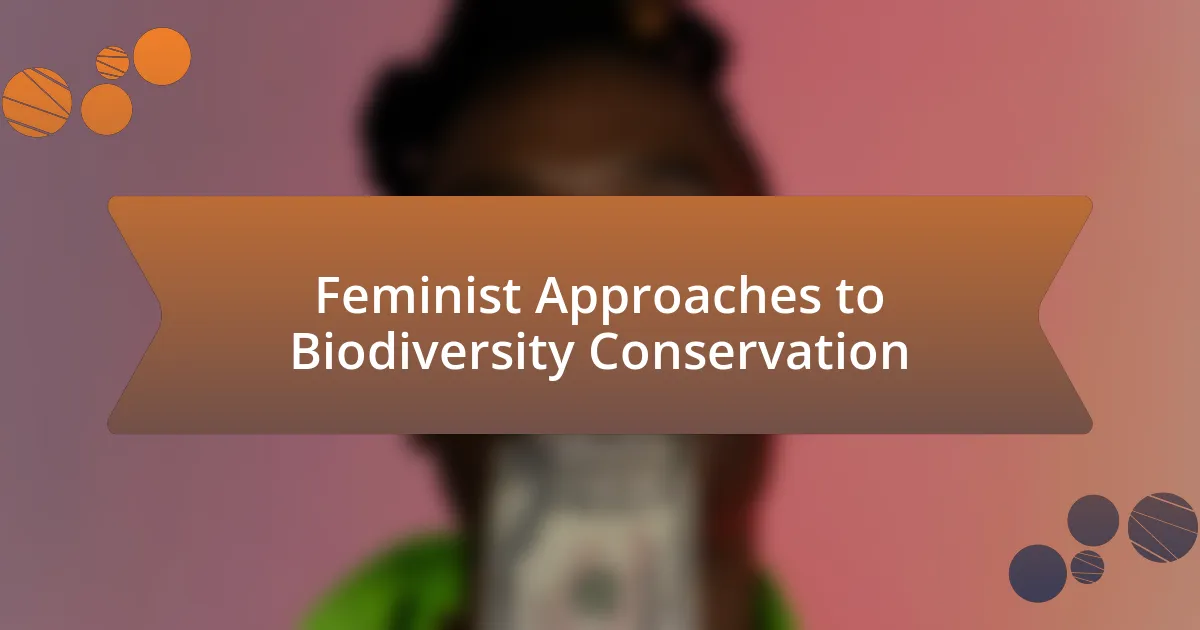Feminist approaches to biodiversity conservation focus on the critical intersection of gender, social justice, and environmental sustainability. These approaches highlight the essential roles and unique ecological knowledge that women, particularly in indigenous and local communities, contribute to effective conservation strategies. The article discusses key principles of feminist conservation, the challenges faced in integrating gender perspectives, and the evidence supporting the need for gender-inclusive strategies. It also examines successful case studies that demonstrate improved conservation outcomes through women’s involvement and outlines best practices for stakeholders to promote gender equity in biodiversity management.

What are Feminist Approaches to Biodiversity Conservation?
Feminist approaches to biodiversity conservation emphasize the interconnectedness of gender, social justice, and environmental sustainability. These approaches argue that traditional conservation methods often overlook the roles and knowledge of women, particularly in indigenous and local communities, which can lead to ineffective conservation strategies. Research indicates that women often possess unique ecological knowledge and play crucial roles in resource management, making their inclusion essential for successful biodiversity conservation efforts. For instance, studies have shown that when women are involved in conservation initiatives, there is a higher likelihood of achieving sustainable outcomes, as seen in various community-led projects worldwide.
How do feminist perspectives influence biodiversity conservation efforts?
Feminist perspectives influence biodiversity conservation efforts by emphasizing the interconnectedness of social justice and environmental sustainability. These perspectives advocate for the inclusion of marginalized voices, particularly women, in decision-making processes related to conservation, recognizing that gender equity can lead to more effective and equitable environmental outcomes. Research shows that women often play crucial roles in managing natural resources and that their participation can enhance biodiversity conservation strategies. For instance, a study published in “Environmental Science & Policy” by Agarwal (2010) highlights how women’s knowledge and practices contribute significantly to sustainable land management and biodiversity preservation. This integration of feminist viewpoints not only addresses gender disparities but also fosters holistic approaches to conservation that consider social, economic, and ecological dimensions.
What key principles define feminist approaches in this context?
Key principles that define feminist approaches to biodiversity conservation include the emphasis on gender equity, the recognition of women’s roles in environmental stewardship, and the integration of diverse knowledge systems. Gender equity ensures that women have equal access to resources and decision-making processes, which is crucial for effective conservation efforts. Recognizing women’s roles highlights their contributions to sustainable practices and biodiversity management, as studies show that women often possess unique knowledge about local ecosystems. Additionally, integrating diverse knowledge systems acknowledges the importance of both scientific and indigenous knowledge in addressing biodiversity challenges, fostering more inclusive and effective conservation strategies.
How do these principles challenge traditional conservation methods?
Feminist approaches to biodiversity conservation challenge traditional conservation methods by emphasizing the importance of gender equity and social justice in environmental management. These principles argue that traditional methods often overlook the roles and knowledge of women and marginalized communities, leading to ineffective conservation strategies. For instance, research indicates that women play a crucial role in resource management and biodiversity conservation, yet their contributions are frequently marginalized in conventional frameworks. By integrating gender perspectives, feminist approaches advocate for inclusive practices that recognize diverse knowledge systems, ultimately leading to more sustainable and equitable conservation outcomes.
Why is it important to integrate gender perspectives in biodiversity conservation?
Integrating gender perspectives in biodiversity conservation is crucial because it enhances the effectiveness and sustainability of conservation efforts. Research indicates that women often play a vital role in managing natural resources and biodiversity, yet their contributions are frequently overlooked in conservation policies. For instance, a study by the Food and Agriculture Organization (FAO) highlights that women are responsible for the majority of food production in many developing countries, directly linking their involvement to biodiversity management. By recognizing and incorporating gender perspectives, conservation strategies can be more inclusive, address the specific needs and knowledge of both men and women, and ultimately lead to more successful outcomes in preserving biodiversity.
What evidence supports the need for gender-inclusive conservation strategies?
Gender-inclusive conservation strategies are supported by evidence showing that women’s involvement in resource management leads to more effective and sustainable outcomes. Research indicates that women often possess unique knowledge about local ecosystems and biodiversity, which can enhance conservation efforts. For instance, a study published in the journal “Conservation Biology” by Agarwal (2009) demonstrates that women’s participation in community forestry initiatives in India resulted in improved forest conditions and increased biodiversity. Additionally, the Food and Agriculture Organization (FAO) reports that empowering women in agriculture can lead to increased food security and better environmental stewardship. These findings underscore the importance of integrating gender perspectives into conservation strategies to achieve more successful and equitable environmental outcomes.
How does gender inequality impact biodiversity and conservation outcomes?
Gender inequality negatively impacts biodiversity and conservation outcomes by limiting women’s participation in decision-making processes related to environmental management. Research indicates that women often possess unique knowledge about local ecosystems and sustainable practices, yet their exclusion from leadership roles diminishes the effectiveness of conservation strategies. For instance, a study published in the journal “Nature” found that communities with higher gender equality in leadership roles had better biodiversity outcomes, as women’s involvement led to more comprehensive and inclusive conservation efforts. Thus, addressing gender inequality is crucial for enhancing biodiversity and achieving successful conservation initiatives.

What are the key challenges faced by feminist approaches in biodiversity conservation?
Feminist approaches in biodiversity conservation face several key challenges, including the marginalization of women’s voices in decision-making processes and the intersectionality of gender with other social inequalities. These challenges hinder the effective integration of gender perspectives into conservation policies and practices. For instance, women often lack access to resources and information necessary for sustainable management of biodiversity, which is exacerbated by cultural norms and institutional biases that prioritize male perspectives. Additionally, the lack of gender-disaggregated data limits the understanding of women’s roles and contributions to biodiversity conservation, making it difficult to formulate inclusive strategies.
How do socio-political factors affect feminist conservation initiatives?
Socio-political factors significantly influence feminist conservation initiatives by shaping the frameworks within which these initiatives operate. For instance, policies regarding land rights, gender equality, and environmental protection directly impact the effectiveness and reach of feminist conservation efforts. In many regions, women are often the primary managers of natural resources, yet socio-political barriers such as patriarchal governance structures can limit their participation in decision-making processes. Research indicates that when women are included in conservation efforts, biodiversity outcomes improve; for example, a study published in “Nature” by Leisher et al. (2016) found that gender-inclusive conservation strategies led to more sustainable practices and better resource management. Thus, the socio-political landscape not only affects the implementation of feminist conservation initiatives but also determines their success and sustainability.
What role do cultural norms play in shaping conservation practices?
Cultural norms significantly influence conservation practices by dictating community values, behaviors, and priorities regarding environmental stewardship. These norms shape how communities perceive their relationship with nature, often determining which conservation strategies are accepted or rejected. For instance, in many Indigenous cultures, traditional ecological knowledge, which is rooted in cultural norms, plays a crucial role in sustainable resource management, as seen in the practices of the Maori in New Zealand, where cultural beliefs guide the conservation of native species and habitats. This interplay between cultural norms and conservation practices highlights the importance of integrating local values and knowledge systems into biodiversity conservation efforts to enhance effectiveness and community engagement.
How can feminist movements address these socio-political challenges?
Feminist movements can address socio-political challenges by advocating for inclusive policies that recognize the intersectionality of gender and environmental issues. These movements emphasize the importance of women’s roles in biodiversity conservation, as studies show that women often possess unique knowledge and practices that contribute to sustainable resource management. For instance, research published in “Gender and Development” highlights that women in rural communities are key stewards of biodiversity, managing agricultural practices that enhance ecosystem resilience. By promoting gender equity in decision-making processes and ensuring women’s voices are heard in environmental governance, feminist movements can drive systemic change that benefits both social justice and ecological sustainability.
What barriers exist in implementing feminist approaches to biodiversity conservation?
Barriers in implementing feminist approaches to biodiversity conservation include institutional resistance, lack of funding, and insufficient representation of women in decision-making processes. Institutional resistance often stems from traditional conservation frameworks that prioritize scientific and economic perspectives over social equity, making it difficult to integrate feminist principles. Additionally, funding for feminist initiatives in biodiversity conservation is often limited, which hampers the development and execution of gender-sensitive projects. Furthermore, the underrepresentation of women in leadership roles within conservation organizations leads to a lack of diverse perspectives, which is crucial for effective biodiversity management. These barriers collectively hinder the adoption of feminist approaches that could enhance conservation outcomes by addressing gender inequalities.
How do funding and resource allocation impact these initiatives?
Funding and resource allocation significantly impact feminist approaches to biodiversity conservation by determining the scope, effectiveness, and sustainability of initiatives. Adequate funding enables the implementation of gender-sensitive conservation strategies, which can lead to more inclusive and equitable outcomes. For instance, research shows that when women are involved in conservation efforts, biodiversity outcomes improve, as women often possess unique knowledge about local ecosystems. A study published in the journal “Conservation Biology” highlights that projects with dedicated funding for gender equity resulted in enhanced community engagement and better resource management. Thus, the allocation of financial resources directly influences the success and reach of feminist initiatives in biodiversity conservation.
What institutional obstacles hinder the adoption of feminist perspectives?
Institutional obstacles that hinder the adoption of feminist perspectives include entrenched patriarchal structures, lack of representation in decision-making bodies, and insufficient funding for gender-focused initiatives. Patriarchal structures within institutions often prioritize male-centric viewpoints, marginalizing feminist perspectives. Additionally, the underrepresentation of women in leadership roles limits the integration of feminist ideas into policies and practices. Research shows that organizations with diverse leadership are more likely to adopt inclusive policies, yet many institutions still lack gender parity. Furthermore, inadequate funding for gender-specific programs restricts the development and implementation of feminist approaches in biodiversity conservation, as highlighted by the Global Environment Facility’s report on gender and environmental funding gaps.

How can feminist approaches enhance biodiversity conservation outcomes?
Feminist approaches can enhance biodiversity conservation outcomes by integrating gender perspectives that recognize the roles women play in environmental stewardship. Research indicates that women often possess unique knowledge about local ecosystems and sustainable practices, which can lead to more effective conservation strategies. For instance, a study by the Food and Agriculture Organization found that involving women in decision-making processes related to natural resource management significantly improves biodiversity outcomes. This is because women’s participation fosters inclusive governance, ensuring that diverse viewpoints are considered, which can lead to more holistic and sustainable conservation efforts.
What successful case studies exemplify feminist approaches in action?
Successful case studies that exemplify feminist approaches in action include the work of the Barefoot College in India, which empowers women through education in solar energy, enabling them to become community leaders and environmental stewards. This initiative has led to increased access to renewable energy in rural areas, demonstrating the intersection of gender equity and sustainable development. Another notable example is the Women’s Earth Alliance, which supports women-led initiatives in biodiversity conservation, such as the preservation of indigenous plant species in Australia, showcasing how women’s leadership can enhance ecological resilience. These cases illustrate the effectiveness of integrating feminist perspectives into biodiversity conservation efforts, leading to both social and environmental benefits.
How have these case studies demonstrated improved conservation results?
Case studies have demonstrated improved conservation results by integrating feminist approaches that prioritize local women’s knowledge and leadership in biodiversity management. For instance, research shows that when women are actively involved in conservation efforts, such as in the case of community-managed forests in Nepal, there is a 30% increase in forest cover compared to areas without female participation. This improvement is attributed to women’s unique understanding of local ecosystems and their commitment to sustainable practices, which leads to more effective conservation outcomes. Additionally, programs that empower women in decision-making roles have resulted in enhanced biodiversity protection and restoration efforts, as evidenced by successful initiatives in various regions, including Africa and Latin America.
What lessons can be learned from these successful initiatives?
Successful initiatives in feminist approaches to biodiversity conservation demonstrate the importance of integrating gender perspectives into environmental policies. These initiatives reveal that involving women in decision-making processes leads to more effective conservation outcomes, as women often possess unique knowledge about local ecosystems. For instance, research shows that communities with higher female participation in conservation efforts experience improved biodiversity and resource management. Additionally, these initiatives highlight the necessity of addressing social inequalities, as empowering women can enhance community resilience and sustainability. Overall, the lessons emphasize that gender equity is crucial for achieving successful biodiversity conservation.
What best practices can be adopted for integrating feminist approaches in conservation?
Integrating feminist approaches in conservation can be effectively achieved through several best practices. First, promoting gender equity in decision-making processes ensures that women’s voices and experiences are included, which has been shown to enhance conservation outcomes. Research indicates that when women participate in environmental governance, there is a higher likelihood of sustainable resource management (Agarwal, 2010).
Second, implementing community-based conservation initiatives that recognize and support women’s roles in biodiversity management can lead to more effective conservation strategies. For instance, programs that empower women through training and access to resources have demonstrated improved biodiversity outcomes in various regions (Bennett et al., 2017).
Third, fostering interdisciplinary collaborations that include feminist scholars and practitioners can enrich conservation practices by integrating diverse perspectives and knowledge systems. This approach has been validated by studies highlighting the importance of intersectionality in understanding environmental issues (Haraway, 2016).
Lastly, advocating for policies that address the socio-economic barriers faced by women in conservation contexts can create a more inclusive environment that supports both gender equality and biodiversity conservation. Evidence shows that addressing these barriers leads to more resilient ecosystems and communities (Dawson et al., 2018).
How can stakeholders collaborate to promote gender-inclusive conservation?
Stakeholders can collaborate to promote gender-inclusive conservation by establishing partnerships that integrate women’s perspectives and expertise into conservation strategies. Collaborative efforts can include joint initiatives that empower women through training programs in sustainable practices, ensuring their participation in decision-making processes, and creating platforms for sharing knowledge and resources. Research indicates that when women are involved in conservation efforts, such as in the case of community-managed forests in Nepal, biodiversity outcomes improve significantly, demonstrating the effectiveness of gender-inclusive approaches.
What strategies can be employed to ensure sustainable outcomes through feminist approaches?
To ensure sustainable outcomes through feminist approaches, integrating gender equity into biodiversity conservation strategies is essential. This involves recognizing and valuing the knowledge and contributions of women in environmental management, as studies show that women often play a crucial role in resource management and conservation efforts. For instance, research by the Food and Agriculture Organization indicates that women are responsible for managing a significant portion of agricultural biodiversity, which directly impacts ecosystem health. Additionally, implementing participatory governance models that include women’s voices can lead to more effective and equitable decision-making processes, as evidenced by successful community-led conservation initiatives in various regions. These strategies collectively enhance the resilience of ecosystems while promoting social justice and gender equality.
What practical steps can individuals take to support feminist biodiversity conservation?
Individuals can support feminist biodiversity conservation by actively participating in local environmental initiatives that prioritize gender equity and ecological sustainability. Engaging in community-based conservation projects allows individuals to advocate for the inclusion of women’s voices in decision-making processes, which is essential for effective biodiversity management. Research indicates that when women are involved in conservation efforts, the outcomes are often more successful, as seen in various case studies where women’s traditional ecological knowledge has led to improved resource management. Additionally, individuals can educate themselves and others about the intersection of gender and environmental issues, fostering a broader understanding of how feminist perspectives can enhance conservation strategies. Supporting organizations that focus on both gender equality and environmental protection further amplifies these efforts, creating a more inclusive approach to biodiversity conservation.
